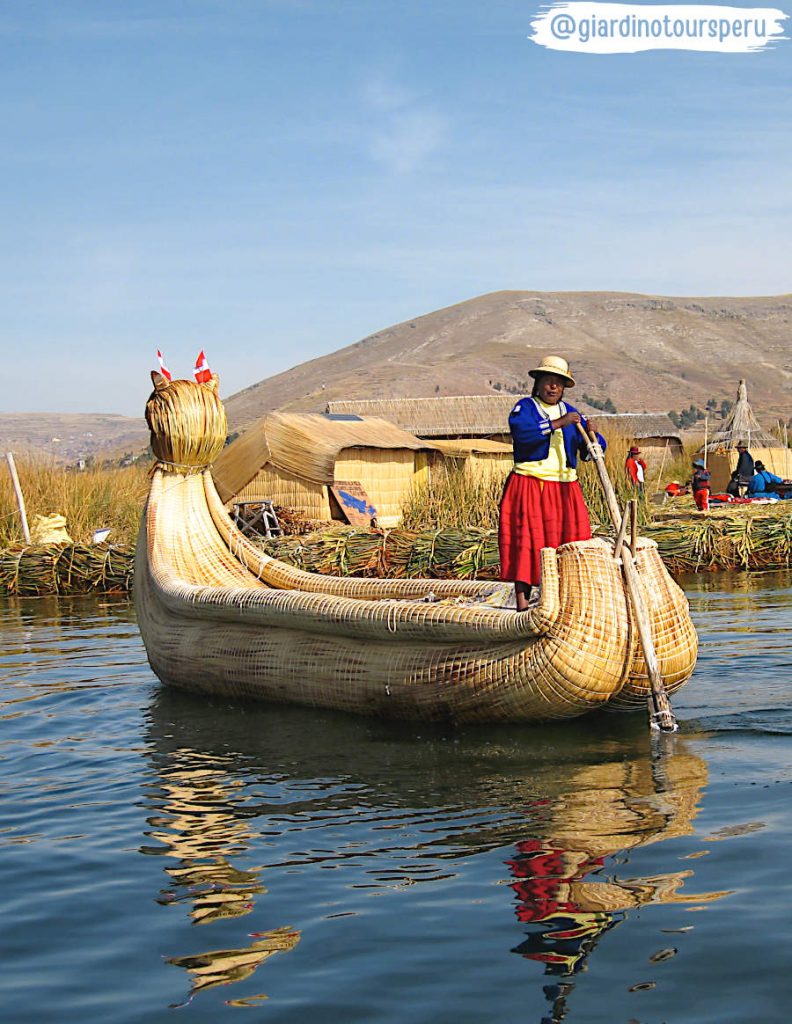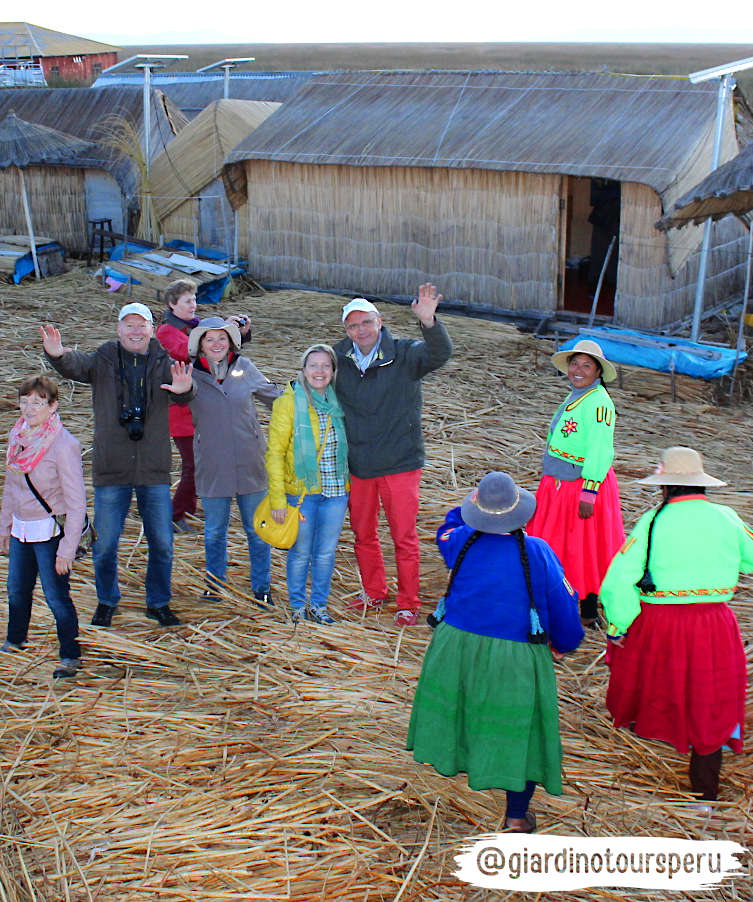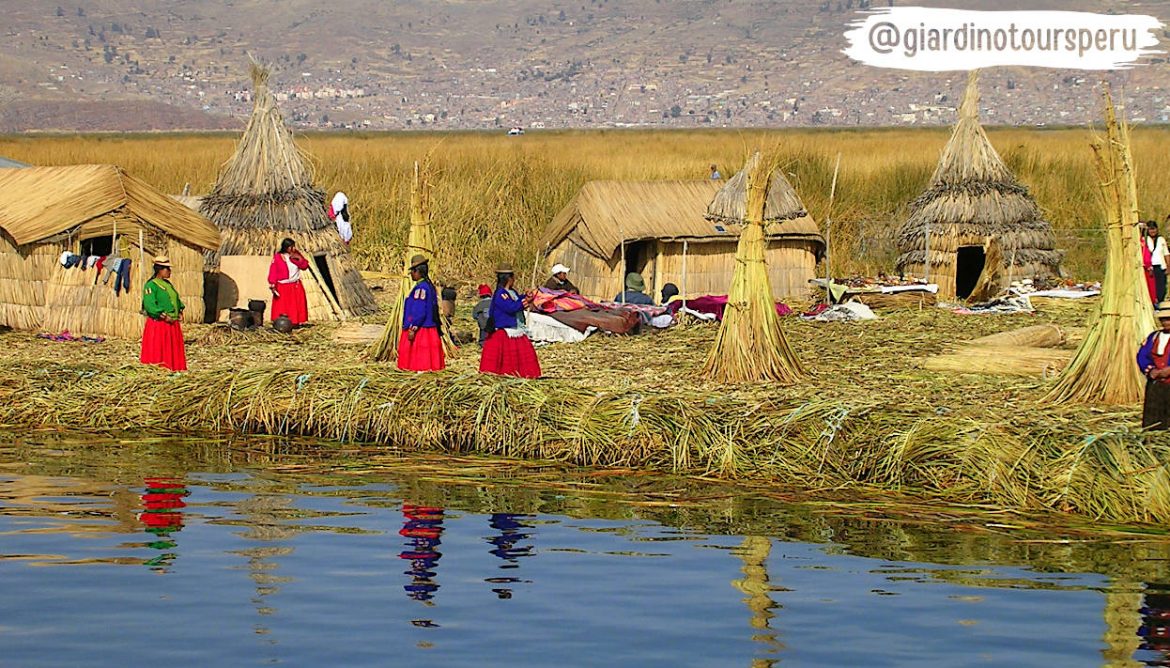The floating islands of UROS are located inside the bay of Lake Titicaca only 14 Km. (about 9 miles) away from the city of Puno (20 to 30 minutes of navigation time). These human-made islands constructed from reeds are without doubt one of the fascinating half-day Tours from Puno on Lake Titicaca. – Perú.
How the islands are made?

The floating islands are constructed from many layers of the totora reeds, which are constantly replenished from the top as they rot from the bottom, so the ground is always soft and dry as much as possible. (When you visit the islands please be careful not to put your foot through any rotten sections!)
Nowadays, the reeds are still very important material for the Uros. They eat the reeds, build boats and houses with them, feed their few animals with reeds, and they use the reeds to make fire and cook.
We can say that the Totora are the backbone of Uros’ life.
Each islet is home to between one and ten Uros families. Also in some islets children are able to attend kindergarten and elementary school . However, older children must continuing their education in Puno city.
That make the future of Uros, their traditions and way of life uncertain.
Origen of the name
“URU” was the name of a very particular ethnic group that co-existed in lake Titicaca with the Inkas, Aymaras and possibly with older civilizations.
Today some theories claim that in the name “Uru” derives from the Pukina language; (also spelled Puquina) and it is already mentioned that this may have been the native and secret language of the Incas, and has remained hidden for hundreds of years.
The first clue to this language is given by the Inca Garcilaso de la Vega in his Royal Comments. In this work, the author tells us the following:
“The Incas had another particular language that spoke between them, that the other Indians did not understand it nor was it lawful for them to learn it, as divine language,”
He also adds that according to information from their sources, this language “had been totally lost, because, The particular republic of the Incas perisched and their language perished too.“
According to documents it is known that the Spanish Empire decreed in 1575 as the official languages of the kingdom of Peru, three languages: Quechua, ayumara and puquina. Languages that were to be learned primarily by Spanish priests for evangelizing purposes.
Rodolfo Cerrón Palomino, Peruvian linguist, explains that the Spanish people had a quite pragmatic approach. So, seeing that the mayority of people already spoke Quechua or Aymara, they did not see the use in creating documents in Pukina language. “We lost a great opportunity to have materials for this language,” laments Palomino.
The Uros People

In fact, it is believed that the Uros people were one of the first ethnic groups populating the Andean region. Contrary to the claim by many authors that the Uros’ ethnic group is extinguished; a recent study of the genetic structure of the Quechua and Aymara groups of lake Titicaca has found that today’s UROS people preserve part of the original gene of ancient Uros.
These people were simple fishermen, bird hunters and recoletc eggs from the reeds and preferred to remain isolated from the other civilizations. Their search for isolation may be one reason why they decided to live in mobile boats on the lake.
When the Spanish chroniclers encountered the UROS by the end of the XVI century, the UROS people were still living on the lake in small reed-boats that they used as floating houses. Only in the early 60s, the Uros started to build small artificial islands with reeds for bigger homes.
Today the Uros Islands are floating on the Peruvian side of Lake Titicaca, a few miles from Puno city. On the past the islands used to be closer to the middle of the lake Titicaca, but they moved or rebuilt the islands closer to the shore after a devastating storm in 1986.
Uros is a gem on Titicaca lake; thanks to existing Uros people, we can still imagine and appreciate the way of life of an ancient ethnic group on the Andean area of Lake Titicaca.
How to book the Tour to Uros Islands

- The best way to visit the Uros Islands is a guided tour from Puno city. All guided tours depart to Uros every day specially during dry season.
- Most boats depart in the morning between 7 and 8 AM. The ride take about 20 minutes to the islands.
- The city of Puno is easily accessible from Cusco, Arequipa, and La Paz, Bolivia.
- Cusco and Puno are well connected with transportation options. From Arequipa, Colca Canyon tours can continue onto Puno by van. Buses run daily to and from La Paz.
- Each tour of Uros begins with a demonstration on how the islands are made. After that, the islanders invite their guests to visit a home built from the same Totora reeds.
The islanders always present their handicrafts to tourists towards the end of each tour. While some visitors find this annoying, it is important to keep in mind that a large percentage of their income comes from selling souvenirs to tourists.
Travel Tips
- The best time to visit the Uros Islands is during the dry season from April to November.
- Bring your passport for a souvenir stamp on one of the main islands (additional cost of 1 sol per stamp).
- Each tour to Uros Islands visits two islands. IN the tour you will have the option to take a handmade reed boat from first island to the second island (15-20 minute ride). This boat ride costs an additional 10 soles per person. This payment goes directly to the family that owns the boat.
- Important: Remember that Uros Islands and Lake Titicaca sit at 12,500 feet (3,810 meters) above sea level. It is best to acclimatize by first visiting cities in lower altitudes such as Arequipa or Cusco before heading to Lake Titicaca.
- Fort he Tour to Uros and specially for tours in the andean area; bring sun protection, warm layers, comfy shoes.
- The best time to depart on Tours to Lake Titicaca is in the morning. Therefore, we recommend staying in a Puno hotel one night before visiting the lake.
Giardino Tours Perú
BLOG
Fuentes:
Wikipedia / www.pucp.edu.pe / Lonely Planet
@GiardinoToursPeru
#ItravelwithGiardino #OneTripManyExperiences

